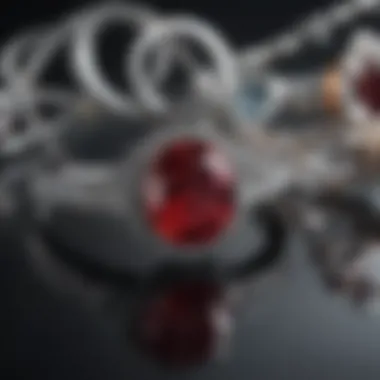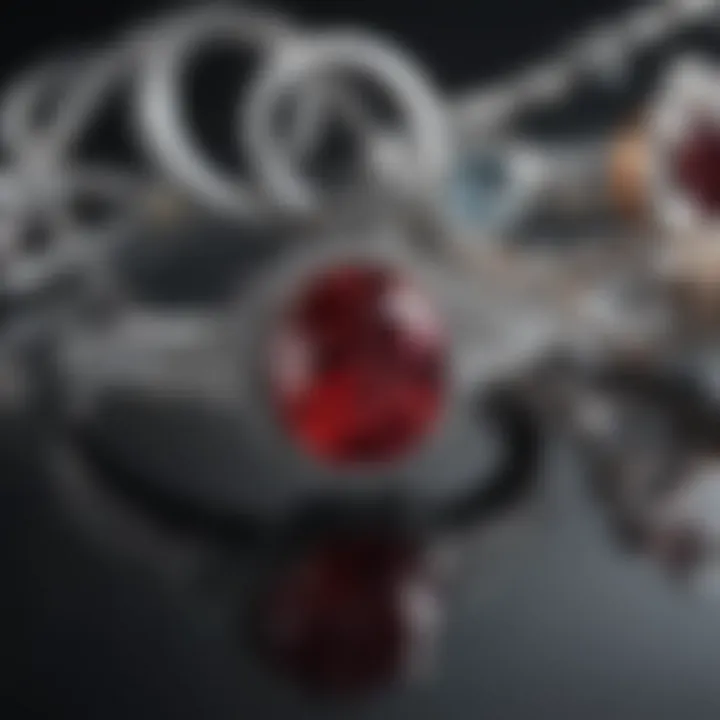Should I Sell My Jewelry? Key Considerations and Guidance


Intro
Selling jewelry can be a complex decision influenced by various factors. Whether you are looking to declutter, raise funds for a specific purpose, or simply move on from a sentimental item, understanding the landscape of jewelry sales is essential. This guide explores the intricacies of selling jewelry, how the market operates, and what to keep in mind emotionally and financially.
Gemstone Overview
Understanding gemstones is crucial when contemplating the sale of your jewelry. Gems not only hold aesthetic appeal but also can represent significant value.
Definition of Gemstones
Gemstones are precious or semi-precious minerals that are cut, polished, and used in various forms of adornment. They are often valued based on quality, rarity, and demand. The value can fluctuate greatly, depending on market trends and personal circumstances.
Classification of Gemstones
Gemstones can be broadly classified into two main categories:
- Precious gemstones: These include diamonds, rubies, sapphires, and emeralds. They are often highly sought after and can command high prices.
- Semi-precious gemstones: This category encompasses a wider array of stones, such as amethyst, garnet, and topaz. While they may not carry the same market value as precious stones, many are still beautiful and valuable in their own right.
When selling jewelry, knowing the classification of the gemstones involved can significantly impact pricing and potential buyers.
Historical Significance
The importance of gemstones throughout history provides context for their value today. Understanding this can deepen one's appreciation for the pieces.
Origins of Gemstone Use
Gemstones have been used for thousands of years, dating back to ancient civilizations. Initially, they were utilized for their beauty and rarity in adornment and ceremonial roles. Over time, they became symbols of wealth and power, often associated with various deities.
Cultural Insights: Gemstones in Ancient Civilizations
In ancient Egypt, for instance, lapis lazuli was revered as a stone of protection and was often used in burial tombs. In India, gemstones were integral to royal regalia, believed to bring luck and prosperity. Understanding these cultural connections can provide insight into the inherent value and significance of your jewelry.
"Gemstones carry stories from ages past, connecting us with the artisans and cultures that treasured them."
Considering these historical aspects can make parting with personal jewelry an emotional rather than purely financial decision.
Prolusion to Jewelry Selling
In the context of personal possessions, jewelry often holds both monetary and sentimental value. For many, jewelry is a symbol of special memories or milestones. However, the decision to sell such items can be complex and significant. This section sets the stage for understanding the multifaceted nature of jewelry selling. The act of selling jewelry is not merely a transaction; it involves careful thought about motivations, market dynamics, emotional attachments, and the broader implications associated with the decision.
Understanding jewelry selling is essential for anyone contemplating this choice. It provides insight into the marketplace, equipping sellers with necessary knowledge to act wisely, potentially maximizing their returns. Additionally, this comprehension can aid in addressing personal motives behind the sale, ensuring that the decision aligns with individual goals or circumstances.
Understanding the Jewelry Market
The jewelry market is an intricate landscape influenced by various factors. Buyer demand fluctuates based on trends, economic conditions, and cultural tastes. Understanding these elements is central to navigating the process of selling jewelry effectively.
- Trends: Styles change over time. What was once trendy may not hold the same value today.
- Demand: Certain gemstones or designs may experience heightened interest, affecting their resale value.
- Economic Factors: The health of the economy can impact consumer spending on luxury items.
Being aware of these factors can assist sellers in timing their sale for optimal returns. Research can help determine if now is the right moment to enter the market.
Reasons to Sell Jewelry
People sell jewelry for various reasons. These motivations can often be both practical and emotional.
- Financial Need: Sometimes, unexpected expenses arise. Selling jewelry can provide quick cash.
- Change in Taste: As people evolve, their preferences regarding styles or gemstones may shift, prompting them to sell items that no longer resonate with them.
- Disinheritance: Families may decide to liquidate inherited pieces. This can happen if the jewelry does not hold sentimental value for the new owner.
- Decluttering: Many individuals seek a simpler, more minimal lifestyle. Selling unused jewelry contributes to this goal.
Each reason provides its own set of considerations. Understanding the motivation behind selling can help clarify the decision-making process and ensure that sellers approach the market with suitable expectations.
Emotional Considerations
Selling jewelry is not merely a financial transaction; it encompasses a myriad of emotional factors. For many, jewelry carries significant sentimental value, often tied to memories, relationships, and life events. Understanding these emotional dimensions can aid individuals in their decision-making process, whether they are motivated by practical needs or personal evolution.
Sentimental Value
The sentimental value of jewelry can greatly influence one's decision to sell. This type of value is often deeply personal and varies from person to person. A ring might remind someone of a wedding day, or a necklace could be associated with a cherished grandmother. Recognizing this emotional bond is essential.
Consider the feelings attached to each piece. Think about its history, when it was received or worn, and the stories connected to it.


Some may find that these memories cause inner conflict when contemplating a sale. They might struggle between the desire to keep cherished relics and the practical need for financial gain. A clear understanding of what the jewelry represents can provide clarity. Individuals should ask themselves: What does that piece mean to them? Are they ready to part with the memories it holds?
Releasing Attachments
Releasing attachments to jewelry can be a transformative process. The act of selling can signify closure, a way to move forward in life while letting go of the past. Emotions such as guilt, fear, or anxiety may arise during this time. It is vital to navigate these emotions, acknowledging them and understanding their impact.
Letting go of jewelry can also be liberating. It may open up possibilities for new experiences and relationships. Individuals can consider how the sale could contribute to their future, whether by funding new adventures, investing in other passions, or supporting financial goals.
In summary, addressing emotional considerations is crucial when selling jewelry. Recognizing sentimental value and embracing the process of releasing attachments can help individuals make informed and empowering decisions. Reflecting on these aspects beforehand might ultimately lead to a more fulfilling outcome.
Valuation of Jewelry
Valuation of jewelry is a critical component to consider when deciding whether to sell your pieces. This step establishes the fair market value of your jewelry items, ensuring you receive appropriate compensation. An accurate valuation can inform your pricing strategy and negotiation approach, and it serves an essential role in protecting both sellers and buyers in the jewelry market.
Understanding the worth of jewelry goes beyond basic aesthetics. Factors such as rarity, craftsmanship, and material quality come into play. For gemstone enthusiasts and collectors, valuation is not just about monetary value; it reflects the piece's significance in their collection. A comprehensive valuation can highlight unique features of the jewelry, presenting these attributes to potential buyers in an informed manner.
Additionally, correctly valuing your jewelry aids in setting realistic expectations. Sellers often have emotional attachments to their items, which can cloud judgment about their actual market worth. By utilizing professional appraisals or certified valuations, sellers can align their expectations with the current market landscape, avoiding potential frustration when it comes time to negotiate.
Gemstone Characteristics
The characteristics of gemstones play a vital role in determining jewelry value. Each gemstone has specific attributes, such as color, clarity, cut, and carat weight, that greatly influence its desirability. Understanding these characteristics is crucial for accurately assessing value.
- Color: The hue, saturation, and tone determine how appealing a gemstone appears. Richer colors often fetch higher prices.
- Clarity: The presence of inclusions or blemishes can significantly affect a gemstone's value. Cleaner stones are generally more valuable.
- Cut: The quality of the cut impacts how well a stone reflects light. Better cuts yield more sparkle and brilliance.
- Carat weight: Larger stones usually command higher prices, though this is relative to the type of gemstone.
Evaluating these attributes requires expertise. Enthusiasts and collectors should consult reliable sources or professionals to get an accurate read on their gemstones' characteristics. This knowledge will enhance their bargaining position when negotiating a sale.
Certification and Appraisal
Certification and appraisal are essential components of the valuation process. A certified gemstone, such as those from the Gemological Institute of America, comes with a detailed report that lists its characteristics. This certification provides a degree of trust and validity, as buyers often seek such assurances before making a substantial investment.
Appraisals are another important aspect. Hiring a certified appraiser gives a reliable evaluation of the jewelry's monetary worth. An appraiser considers multiple factors, including market trends, to assign a value that reflects both current demand and intrinsic qualities. Furthermore, having a recent appraisal can help in negotiations, as it will substantiate your asking price.
Market Trends and Pricing
Understanding market trends is central to pricing strategies for selling jewelry. The jewelry market can fluctuate based on various economic factors, including demand and supply dynamics, trends in consumer preferences, and global economics.
- Demand and supply: High-demand periods can drive prices up, while oversupply can decrease values.
- Consumer preferences: Trends in fashion influence what styles and types of jewelry are more desirable at any given time.
- Global economics: Economic conditions, including inflation or commodity prices, can impact the pricing of precious metals and stones.
Keeping track of these trends equips sellers with the knowledge necessary to set competitive prices. Consider researching popular jewelry platforms and reading industry reports to glean insights on current market conditions. By doing this, sellers can make informed decisions, ultimately leading to more successful sales.
"Understanding the valuation process equips sellers with the knowledge the need to optimize their negotiations and secure favorable sales outcomes."
Choosing the Right Time to Sell
Understanding the timing of your jewelry sale is crucial. It can mean a significant difference in the financial outcome of the transaction. Many factors influence when to sell jewelry, so it's essential to analyze both market conditions and personal circumstances. Evaluating these aspects will help you create a strategy that not only maximizes profit but also brings clarity to your personal decision.
Market Conditions
Market conditions are a key factor that impacts the value of jewelry. They encompass various elements including the economy, demand for specific jewelry types, and fluctuations in precious metal prices. When markets are strong, potential buyers are typically more willing to pay higher prices. Conversely, during economic downturns, buyer confidence may drop, which can lead to decreased offers for items.
Keeping an eye on the trends can be beneficial. For instance, an upsurge in gold prices might indicate a good time to sell gold jewelry. Also, specific types of gemstones may gain popularity, resulting in increased demand. Engaging with resources like Britannica can offer insights into market trends.
Furthermore, seasonal factors affect sales. The holiday season often brings increased consumer spending. Thus, selling jewelry around holidays may result in higher prices and quicker sales.
Personal Circumstances
Your personal context is equally significant when deciding to sell jewelry. This involves factors related to your life changes, financial needs, or intentions connected to the jewelry in question. If you are facing financial pressures—such as unexpected expenses or a transition in your life—selling jewelry can provide needed liquidity.
Additionally, emotional readiness is vital. Parting with jewelry, especially heirlooms, may create conflicting feelings. Reflecting on the reasons behind the desire to sell can help align your emotions with your actions.
It is also wise to consider any upcoming life changes that may influence your decision. For instance, if you expect a shift in job status or relocation, it may prompt you to assess your jewelry collection more critically. Make sure that your reasons to sell resonate with your current needs and overall goals.
Deciding to sell jewelry should stem from a well-assessed combination of market conditions and personal circumstances.
Where to Sell Your Jewelry
Selling jewelry is a significant decision that cannot be taken lightly. The choice of venue plays a crucial role in the outcome of the sale. Selecting the right platform not only influences the final price but also determines the level of convenience, safety, and trust involved in the process. The landscape for selling jewelry is diverse. Each option has its own set of advantages and challenges, which this section will explore in detail.


Jewelry Stores and Dealers
Jewelry stores and dealers offer a traditional yet reliable avenue for selling your pieces. They are typically knowledgeable about the market and can provide a fair assessment of the value of your jewelry.
- Immediate Sale: One of the main benefits of selling to a jewelry store is the immediate transaction. You can walk in, have your piece appraised, and walk out with cash.
- Trust and Security: Established jewelry dealers often have a reputation to uphold. They tend to provide a secure environment for transactions, reducing possible risks.
- Expertise: Many jewelers possess deep knowledge of the jewelry market, which may result in a more accurate valuation of your piece compared to less experienced sellers.
However, it is essential to be aware of potential downsides. Some stores may offer lower prices than private sales or online platforms due to resale markup. Consider visiting multiple stores and requesting quotes to ensure the best outcome.
Online Marketplaces
In recent years, online marketplaces have become increasingly popular for selling jewelry. Platforms such as eBay, Etsy, and even Facebook Marketplace allow sellers to reach a vast audience.
- Broader Exposure: Online platforms provide a much larger potential buyer base. This increases the chances of finding someone willing to pay a price aligned with your expectations.
- Control over Pricing: Sellers often have more control over the listing and pricing of their items. You can set the price that reflects your jewelry's perceived value.
- Flexibility: Selling online allows for a more flexible schedule. You can sell from the comfort of your home at any time.
However, it is vital to approach online selling with caution. Ensure your descriptions are accurate and provide detailed images. Furthermore, be aware of fees that the platforms might charge. Understanding shipping and return policies is also crucial to avoid issues later.
Auction Houses
Auction houses present another option for selling jewelry, particularly for unique or high-value pieces. Auctions generally attract collectors and individuals who are specifically looking for rare items.
- Competitive Bidding: The auction process can drive up the price as interested buyers compete for the item. If your jewelry is desirable, this can yield a higher selling price than in traditional sales.
- Professional Handling: Reputable auction houses manage the entire selling process, from appraisal to marketing. This can relieve the seller from many burdens associated with sale.
- Specialization: Many auction houses specialize in jewelry, attracting knowledgeable buyers who appreciate the nuances of the pieces up for sale.
Nonetheless, working with auction houses can also have drawbacks. Sellers typically must pay a commission based on the sale price, which can significantly reduce profits. Moreover, auctions may take months to complete, so patience is essential.
When deciding where to sell your jewelry, it is crucial to consider the value of convenience versus potential returns. Research, compare options, and choose a method that aligns with your goals.
Preparing Your Jewelry for Sale
Selling jewelry requires strategic preparation. Properly preparing your jewelry not only enhances its appeal but also potentially increases its market value. This step is crucial as buyers often make decisions based on first impressions.
Cleaning and Presentation
Cleaning your jewelry is the first step in the sale process. Over time, jewelry can accumulate dirt and oils. A clean piece appears more attractive and is likely to fetch a better price. Use gentle cleaning methods. For gold and silver, a soft cloth and mild soap may be enough. However, items with gemstones may require special care. For example, avoid harsh chemicals that can damage stones like opals or pearls.
Presentation is equally important. Take high-quality photographs that clearly show every angle of the piece. Natural lighting helps to showcase the jewelry's brilliance. Consider using a plain background to reduce distractions.
Additionally, organize the jewelry logically. Create a systematic way to display items to help potential buyers understand what is available. Think about investing in a simple display box or stand, which enhances visibility and helps items appear more professionally presented.
Documenting Ownership and History
Documenting the ownership and history of jewelry can greatly enhance its value. Potential buyers appreciate insight into a piece’s background. Collect any documents, such as appraisal records, receipts, or authenticity certificates. These items provide proof that can assure buyers of the piece's quality and legitimacy.
If the jewelry has a unique story, don’t hesitate to share it. For instance, if a piece was a gift or has a special significance, detailing that can create a stronger emotional connection with buyers.
Consider creating a simple portfolio of all relevant documents and information. This can include:
- Original receipts
- Appraisal documents
- Certificates of authenticity
- Any other relevant papers
Organization of this information not only provides clarity but can also justify the price you set. A well-prepared sale enhances trust and reflects a genuine intent to provide buyers with a valuable piece.
Negotiating the Sale
Negotiating the sale of jewelry is a crucial aspect of the selling process. Understanding how to effectively communicate with buyers can significantly influence the final outcome of the transaction. This section will focus on essential elements such as setting a realistic price and comprehending buyer psychology. Recognizing these factors can enhance the selling experience and increase the likelihood of a successful negotiation.
Setting a Realistic Price
One of the first steps in negotiating the sale of jewelry is establishing a realistic price. This task involves research and an understanding of the current market value of similar pieces. There are several considerations when determining a price:
- Market Research: Investigate recent sales of similar items. Websites like en.wikipedia.org and reddit.com can offer insights through forums where buyers and sellers discuss prices.
- Jewelry Appraisal: Obtain a professional appraisal to ascertain the value based on gemstone quality, craftsmanship, and brand reputation.
- Condition and Presentation: Assess the physical state of the jewelry. A well-maintained piece will command a higher price compared to one that requires repair or cleaning.
When pricing your jewelry, it is wise to factor in a margin that allows for negotiation. Buyers often expect to negotiate. By setting an initial price slightly above your minimum acceptable price, you can create room for discussions without underselling your asset.
Understanding Buyer Psychology
Understanding the psychology of buyers can greatly impact your negotiation strategy. Buyers are not only evaluating the financial aspect but they are also influenced by emotions and perceptions. Here are some key points to consider:


- Emotional Connection: Jewelry often carries sentimental value. Buyers may be drawn to specific pieces because of their own personal stories or memories. Acknowledge these feelings during discussions.
- Scarcity and Value Perception: The principle of scarcity can heighten demand. If you can convey that the piece is unique or in limited availability, it may justify a higher price.
- Confidence and Authority: Present yourself with confidence when negotiating. Knowledge about the jewelry and the market significantly boosts your credibility, making buyers more inclined to agree with your pricing.
"Negotiation is not merely about haggling over price, but a dialogue to understand perspectives and reach a mutually beneficial agreement."
Approaching negotiations with an understanding of these psychological elements can create a more favorable environment. This will help the buyer feel respected and valued, making it more likely for them to proceed with the transaction.
Legal and Ethical Considerations
When contemplating the sale of jewelry, understanding the legal and ethical considerations is crucial. This knowledge ensures that sellers act within the confines of the law while maintaining integrity and transparency throughout the transaction process. Legal frameworks govern various aspects of jewelry sales, helping to protect the rights of both sellers and buyers. Ethical considerations, on the other hand, highlight the importance of honesty and transparency in dealings. Sellers must recognize the significance of these principles to safeguard their interests and those of their clients.
Transferring Ownership
Transferring ownership of jewelry involves several steps that require careful attention. For a legal sale to occur, proper documentation is essential. This often includes receipts, certificates of authenticity, and any relevant appraisals. The absence of such documents can lead to disputes or complications in the future, particularly regarding claims of ownership.
Before proceeding with a sale, sellers should ensure all documents are in order to facilitate a smooth transfer. If a piece of jewelry has been gifted, sellers may also want to understand the legal implications surrounding the transfer, especially in cases of divorce or inheritance.
Additionally, it is wise to verify the buyer's intentions. Doing so can prevent potential issues such as disputes over the jewelry's provenance or misrepresentation. Always put these steps into practice to maintain clarity and legal protection during the transaction.
Disclosure of Conditions
Disclosure of conditions pertains to the obligation of sellers to inform buyers about the state of the jewelry. This includes its physical condition, any repairs made, and its authenticity. Transparency significantly affects buyer trust and can influence the sale's success.
It is advisable to accurately describe the jewelry, including details like:
- Any visible wear, scratches, or damage
- Whether the piece has been altered or repaired
- The presence of any known issues with gemstones or metal
"Transparency in sales fosters trust and ensures a positive experience for both parties."
Failure to disclose relevant information can lead to disputes post-sale, which may result in refunds or legal action. Buyers must feel assured that they are making a sound investment. Therefore, taking the time to provide full disclosure can enhance the seller's credibility and promote a positive reputation in the market.
After the Sale
Selling jewelry is not just a process of transaction; it also opens a new chapter in the owner’s journey. This phase involves important considerations that can significantly impact the seller's financial stability and emotional well-being. Understanding what happens after the sale provides valuable insights for anyone involved in the jewelry market.
Financial Planning
Once the sale is concluded, the financial implications become paramount. The immediate influx of cash can be appealing, but without a clear plan, it may dissipate quickly. Careful financial planning is essential to maximize the benefits of such a sale. Here are some factors to consider:
- Budget Allocation: Determine how to allocate the funds received from the sale. Are there debts to clear, investments to make, or perhaps a future purchase to plan?
- Emergency Fund: Prioritize setting aside a portion of the proceeds for unexpected expenses. This will create a financial cushion that can alleviate stress in future situations.
- Investment Opportunities: Consider using the funds for investments that align with your financial goals. Whether it’s stocks, bonds, or even art, a well-thought-out investment could yield returns.
- Donations: This can be a chance to contribute to a charitable cause. Allocating just a small percentage of the sale can result in a positive impact on the community.
In preparation for any financial moves, it can be beneficial to consult with a financial advisor. Their expertise might offer insights that help in navigating the post-sale scenario effectively.
Emotional Closure
Equally significant is the emotional aspect that follows selling jewelry. Jewelry often carries sentimental weight. Therefore, achieving emotional closure is crucial after parting with cherished pieces. Here are points to contemplate:
- Reflection on Memories: Take time to reflect on the memories associated with the jewelry. Acknowledging these feelings can lead to acceptance and peace.
- Creating New Traditions: It can be healing to establish new traditions that honor the experience of ownership. This could involve sharing stories with family or repurposing the funds into new experiences, like travel or education.
- Journaling: Writing about the experience can help in processing emotions. Recording thoughts might reveal deeper feelings and support healing.
- Support Systems: Engaging with friends or support groups can provide additional perspectives and encouragement. Sharing the journey with others might make the transition easier.
"Emotional closure is as vital as financial planning; both must be addressed to fully embrace the change that follows a sale."
Throughout this process, remember that feeling a range of emotions is normal. Transitioning from ownership to selling can be both liberating and challenging. Taking time to navigate these feelings is an important part of the overall experience.
Epilogue
In this article, the conclusion serves as a vital summary of the journey the reader has undertaken in evaluating the decision to sell their jewelry. This section ties together the insights gained from earlier discussions, reinforcing the importance of informed decision-making. The significance lies not only in the potential financial gain but also in the emotional implications of letting go of one’s jewelry. Understanding both the market dynamics and one's personal motivations can lead to a more satisfactory outcome.
Reflecting on the Decision to Sell
When contemplating whether to sell jewelry, reflection is crucial. It is essential to assess personal reasons for selling. Is it driven by financial necessity, desire for change, or perhaps a response to changing life circumstances? Taking a moment to evaluate these factors helps clarify intentions.
One must consider what the jewelry represents. For many, pieces may carry significant historical or emotional weight. Reflecting on memories associated with them can also offer insights into whether selling is the right choice. An ecological consideration arises here as well; recycling jewelry can contribute to sustainable practices, making a positive environmental impact.
Ultimately, the decision should align with both personal values and financial needs. Weighing pros and cons thoughtfully aids in arriving at a conclusion. This introspective process ensures that the sale is more than a mere transaction, fostering a sense of closure.
Future Considerations in Jewelry Ownership
Once the decision to sell is made, it is important to think about what comes next. Future considerations can influence how one approaches jewelry ownership thereafter. Selling jewelry might lead one to reevaluate their collection; perhaps more thoughtful, curated choices will be made in the future.
Monitoring market trends remains essential for anyone involved in jewelry, whether it's for investment purposes or personal enjoyment. Being diligent about future purchases, choosing certified gems, and adhering to ethical sourcing practices can shape a better engaging experience.
Furthermore, individuals should consider the possibility of investing in different types of jewelry that align more with their current interests and lifestyle. This may include modern designs or sustainable brands that reflect one’s values.
Regularly reassessing one’s jewelry collection can be beneficial. Keeping track of emotional attachments and financial value aids in forming a conscientious approach to future purchases. Empowering oneself with knowledge will lead to more satisfying decisions about jewelry ownership moving forward.



